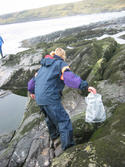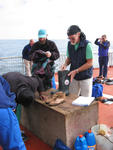Climate Change and Plantlife

Azorella selago, a curious cushion-like plant, has already assisted scientists in understanding how climate change will shape the plant life of the island.
It is known that Azorella helped to pioneer life on Marion Island - it is a tough, slow- growing plant that forms in a tight configuration with hardy stems and leaves.
This makes it able to withstand the extremes of polar deserts and the island's near-barren lava slopes. But it doesn't like to compete for real estate so, on the lower, lush contours of the island, it is easily overrun by grasses, ferns and moss.
Azorella moves in where few others can go, establishes itself, and sets up comfortable little habitats where communities of mites and other insect-like creatures can live. These creatures are nineteen times more prolific in the cushions that on the fell-fields surrounding them.
Azorella is a pleasure dome to life forms that simply could not hack it on Marion otherwise.
Many Azorella cushions have grasses waving out of them like ostrich feathers from a hat - the plant allows the less robust grasses to take root in areas that would otherwise be too hostile for their survival. Where Azorella leads, other life forms follow.
A Good Case Study
A series of experiments have been conducted on some Azorella plants near the research base. A community of plants on a fell-field to the north-east of the island was exposed to a simulation of conditions that might be expected if climate change predictions come to pass.
Some cushions were sheltered from rain and allowed to warm. Others were shaded. After a year, their condition was compared with non-manipulated cushions. Associate professor at Stellenbosch University's Department of Conservation Ecology, Melodie McGeoch, explains why Azorella makes a good case study.
'Azorella is unique because it grows on fell-fields in a type of monoculture. It forms islands, each with its own discrete boundary, which makes it so much easier to study. These islands mean there are few influencing factors so it's easier for biologists to understand than a complex, open-ended system.' It's like a metaphor for Marion's greater ecosystem. 'If you get to the bottom of how this system functions, them potentially you can extrapolate to other systems.
' Most of the island's indigenous and alien plants occur in its more hospitable lower altitudes where Azorella struggles to survive the throng. If the climate continues to warm and dry, these plants will move higher up the island as conditions become more favourable and directly into previously inhospitable areas where Azorella enjoys a roomy, if lonely existence. These species may overwhelm the cushions. Azorella will also move higher and further into the hinterland, trailblazing as it goes.
The experiment findings show that shading - a simulation of the secondary effects of climate change as grasses inundate the cushions - causes etiolation, where the stems grow further apart and the leaves bigger, making them less resistant to ice and wind. Reduced rainfall produced stem damage in the experimental plants, with earlier autumnal ageing and dying back.
McGeoch concluded that climate change - in terms of decreased rainfall and the indirect effect of shading by other successful plants - is likely to take its toll on Azorella. Since it is a nutrient-rich life support to others, the impact will ripple through this fell-field ecosystem. The number of tiny animals present in cushions dropped radically as their home dried out.
But each species responded uniquely to its changing climatic conditions. Some thrived while others disappeared. It is impossible to say whether species packed up and left the cushions when things became too dry for them, or whether they died, or were simply less able to reproduce successfully.
Whatever the case, it's safe to say that even in as 'simple' an ecosystem as an Azorella cushion, there is no quick answer to how an entire suite of species will respond to the warming, drying and other changes expected to impinge on them as global climate change gears up.
Saving the Ecosystem

In the meantime, strategies are in place to save the ecosystems of the Prince Edward Islands from further ruination. A strict environmental management plan controls who visits the islands and how often.
The plan also does whatever is possible to prevent foreign plant or animal species from sneaking in with every visit.
Prior to the departure of any ship bound for Marion Island, conservation officers inspect the ship and all equipment and food containers for insects, seeds, mice or rats.
Before disembarking from the ship, all people visiting the island have their boots scrubbed with bleach in a ritual boot-washing ceremony. Backpacks and any other gear going out into the field are inspected.
Fresh fruit and vegetables, seeds or pips of any kind are not allowed anywhere near the island. Even poultry products are irradiated to prevent the introduction of avian diseases to the island's birds. Poultry waste is frozen and returned to the mainland for disposal.